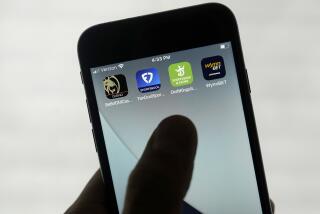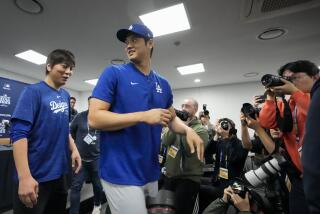A day of reckoning for Lance Armstrong’s fans
Tim Loranger is a Los Angeles aviation attorney who was deeply moved by Lance Armstrong’s story of beating cancer. The former Marine wears the Armstrong yellow wristband, races in an Armstrong hat and has raised thousands of dollars for Armstrong’s cancer charity.
He’s not convinced that Lance Armstrong used performance-enhancing drugs.
“I don’t think they have proven a case against him,” Loranger said.
All due respect to Loranger, a dedicated philanthropist who has watched family and friends endure cancer, but the evidence is in: Armstrong used blood transfusions, the blood booster EPO, and testosterone “from start to finish” in winning an unprecedented seven Tour de France championships, the United States Anti-Doping Agency said last week. Now we can say it straight: Lance Armstrong is a doper.
Yet Loranger isn’t alone. Armstrong still denies it; his spokesman, Mark Fabiani, argues the agency was “bending the rules at every opportunity,” and its findings can’t be trusted.
On one online forum after another, commenters attacked the anti-doping agency’s case or insisted it doesn’t matter.
What are we to make of this refusal to accept overwhelming evidence? No one cares?
Well I care. There’s only one way to play sports: by the rules.
Let’s run down some of the objections the Armstrongers raise against the anti-doping agency’s proof:
• Armstrong never failed a dope test: Armstrong underwent far fewer tests than the 500 to 600 he has claimed, failed one and dodged others, the agency said. After testing positive for a cortisone injection, Armstrong had a prescription for cortisone cream back-dated, its report said. He said it was used to treat a saddle sore.
•The evidence against Armstrong is circumstantial: Nine professional cyclists were clients of Michele Ferrari, an Italian doctor hired by Armstrong, and gave eyewitness accounts of his doping practices; their statements are corroborated by financial records showing that Armstrong paid Ferrari $1 million, according to the agency’s report. This is just the kind of case prosecutors like to tuck into their briefcases on their way to court.
And no, the U.S. attorney in Los Angeles did not clear Armstrong when he dropped a grand jury investigation into the cyclist in February. The case can be reopened and the agency evidence was developed independently of the criminal investigation.
•Armstrong’s accusers have not been cross-examined: Armstrong in August walked away from a chance to put them on the grill. He and his lawyers said that’s because the anti-doping agency’s investigation was stacked against him, but he could have shown that at a hearing. Instead, he blew it off.
I could go on, but the real question is: Why does this matter?
Contrary to the rationalizers, not everybody was doping. Competitors who rode clean were cheated of a fair contest.
More importantly, Armstrong bullied his teammates into doping, supplied them with drugs and left their careers in tatters, the agency reported. When they talked about doping, he threatened their livelihoods, the report said. His Irish masseuse, Emma O’Reilly, told the New York Times that Armstrong impugned her as a prostitute with a drinking problem.
Livestrong, Armstrong’s cancer charity, is no celebrity trifle. Armstrong has raised tens of millions of dollars for the charity, which is well-regarded in many circles for helping cancer survivors live better and overcome stigma.
But to my mind, Armstrong used the charity as a force-field to ward off doping accusations. He cultivated a public face both as a victim of the most dreaded disease of our time and a warrior vanquishing it. Quite a neat trick.
The Armstrongers shrug their shoulders: What are you going to do? Armstrong didn’t invent doping, their argument goes, and you can’t fight it. Bring on the pharmaceutical freak show, and may the best Dr. Frankenstein win.
Do these people play sports or just watch them? Throwing the sport wide open to pharma-meddling won’t award the best cyclist, as they claim. It will award the best doper. And that would not only be immoral, and possibly dangerous. It would leach the magic from the sport.
The romance of cycling is a lone rider gritting up the Rockies beside a dancing creek, or schussing down a coastal incline. It is not a grubby little refrigerator stuffed with vials of fluids, or athletes hooked up to wheezing bags of blood with Dr. Vampire standing by thumbing rolls of cash.
Professional cycling inspires people to live clean and healthy and push for their personal best. The rest of it, the money and endorsements, is corporate noise.
But can anything really be done to clean up the sport? Forget about rectifying old titles and records. Ticking down the list of finishers to find a clean rider is a fool’s errand. Everybody wasn’t doing it, but the top guys clearly were.
However, the sport going forward can police itself a lot better. Cyclists including Armstrong wriggled out of drug testing by ludicrously simple stratagems like fleeing a hotel, dropping out of a race or simply not answering their door, the anti-doping agency said.
Sure, dopers will discover new chemicals, and we won’t always catch them right away. But that’s no reason not to try. The threat of stringent enforcement is a powerful deterrent. Doping enforcement in cycling hasn’t posed a credible threat for a long time, if ever.
If Armstrong really cares about his charity, he should step down as the public face of Livestrong. Although his supporters are in full throat now, the doping scandal eventually will inflict damage, CharityWatch President Daniel Borochoff said.
“It will take a while before people accept it,” he said. “But this latest evidence is so damning.”
After leaving cycling, Armstrong has competed in marathons and triathlons, and according to the agency, he’s remained in consultation with the Italian doctor. He shouldn’t be allowed to taint these other sports.
A hero is a hard thing to give up. But a liar and a cheat is no hero.
More to Read
Start your day right
Sign up for Essential California for news, features and recommendations from the L.A. Times and beyond in your inbox six days a week.
You may occasionally receive promotional content from the Los Angeles Times.






